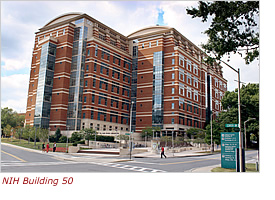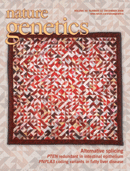 |
 |
Division of Intramural Research
 |
Overview |
 |
Vision, Mission and Values |
 |
Organizational Chart |
 |
Research Branches
|
 |
Research Investigators
Profiles, publications, links |
 |
Clinical Research
Clinical trials, patient recruitment, IRB, FAQ, Overview |
 |
NHGRI Affiliated Centers
CIDR, NCGC, NISC
|
 |
Online Research Resources Developed at NHGRI
Databases, software, tools, more. |
 |
Division of Intramural Research Calendar
Workshops, conferences, seminar series, courses, more. |
 |
Books and Publications |
|
 |
 |
In Other Sections:
|
 |
 |
|
 |

Home Research Research  Intramural Research Intramural Research
The Division of Intramural Research
 |
NHGRI's Division of Intramural Research plans and conducts a broad program of laboratory and clinical research to translate genomic and genetic research into a greater understanding of human genetic disease, and to develop better methods for the detection, prevention and treatment of heritable and genetic disorders. |
News and Events
 |
 Research supported in part by NHGRI provides the strongest genomic evidence to date that more males than females participated in the human dispersal out of Africa 60,000 to 100,000 years ago. The finding is based on analysis of very large DNA data sets collected from four geographically diverse populations and compared patterns of genetic variation between the sex chromosome X and the non-sex chromosomes (autosomes). The analysis detected accelerated genetic drift beyond what would be expected on the X chromosome relative to the autosomes. Genetic drift is the tendency over many generations for a chance mutation to become a more common variation within the genome of a species. The significant difference in variation led the authors to conclude that a disproportionately larger number of males than females migrated out of the African continent to establish the founding population which later split into the European and Asian populations. James Mullikin, Ph.D., associateinvestigator, Genome Technology Branch, NHGRI, co-authored the paper with colleagues at the Harvard Medical School and the Broad Institute of Harvard and MIT. "We can now get a better glimpse of the migration patterns during in the African dispersion event(s)," he said, noting that his role included preparing the large datasets while maintaining the fidelity of the underlying signals for the analysis to pick up on these historic events. Accelerated genetic drift on chromosome X during the human dispersal out of Africa is published in the December 21, 2008 advance online issue of the journal Nature Genetics.
[Full Text
Research supported in part by NHGRI provides the strongest genomic evidence to date that more males than females participated in the human dispersal out of Africa 60,000 to 100,000 years ago. The finding is based on analysis of very large DNA data sets collected from four geographically diverse populations and compared patterns of genetic variation between the sex chromosome X and the non-sex chromosomes (autosomes). The analysis detected accelerated genetic drift beyond what would be expected on the X chromosome relative to the autosomes. Genetic drift is the tendency over many generations for a chance mutation to become a more common variation within the genome of a species. The significant difference in variation led the authors to conclude that a disproportionately larger number of males than females migrated out of the African continent to establish the founding population which later split into the European and Asian populations. James Mullikin, Ph.D., associateinvestigator, Genome Technology Branch, NHGRI, co-authored the paper with colleagues at the Harvard Medical School and the Broad Institute of Harvard and MIT. "We can now get a better glimpse of the migration patterns during in the African dispersion event(s)," he said, noting that his role included preparing the large datasets while maintaining the fidelity of the underlying signals for the analysis to pick up on these historic events. Accelerated genetic drift on chromosome X during the human dispersal out of Africa is published in the December 21, 2008 advance online issue of the journal Nature Genetics.
[Full Text ] ]
|
 |
 In a study published Dec. 5, 2008 in PLoS Genetics, a research team led by Kyungjae Myung, Ph.D., proposed a new molecular pathway for gross chromosomal rearrangements, which are frequently observed in many cancers. They observed gross chromosomal rearrangement in cells with high expression of a specific oncogene, providing a mechanistic bridge between transcription and genomic instability. Spt2p Defines a New Transcription-Dependent Gross Chromosomal Rearrangement Pathway.
[Full Text] PLoS Genetics, Dec. 5, 2008.
In a study published Dec. 5, 2008 in PLoS Genetics, a research team led by Kyungjae Myung, Ph.D., proposed a new molecular pathway for gross chromosomal rearrangements, which are frequently observed in many cancers. They observed gross chromosomal rearrangement in cells with high expression of a specific oncogene, providing a mechanistic bridge between transcription and genomic instability. Spt2p Defines a New Transcription-Dependent Gross Chromosomal Rearrangement Pathway.
[Full Text] PLoS Genetics, Dec. 5, 2008.
|
 |
 Three papers in the Dec. 07, 2008 advance online edition of Nature Genetics include co-authors from NHGRI's Genome Technology Branch. Three papers in the Dec. 07, 2008 advance online edition of Nature Genetics include co-authors from NHGRI's Genome Technology Branch.
One study examined genetic variants and cholesterol levels in more than 40,000 individuals, and locating 30 genetic variants associated with cholesterol levels, including 11 new ones. Several of the newly implicated genetic variants were also related to risk of gallstones and certain rare forms of diabetes.
Lori L. Bonnycastle, Kari A. Kubalanza, Mario A. Morken, Amy J. Swift and Francis S. Collins, and a large group of international collaborators were among the co-authors. Support for the research includes intramural funding and extramural grants from NHGRI. Common variants at 30 loci contribute to polygenic dyslipidemia [Full Text ] ]
A study that looked at the genomes of 36,000 individuals identified genetic changes in the melatonin receptor gene that are strongly associated with a small increase in glucose levels in non-diabetic individuals. The same changes increased the risk of developing diabetes by up to 20 percent. Michael R. Erdos, Lori L. Bonnycastle, Francis S. Collins and a large group of international collaborators were among the co-authors. Support for the research includes intramural funding and extramural grants from NHGRIVariants in MTNR1B influence fasting glucose levels
[Full Text ] ]
The third study accompanies the findings regarding changes in the melatonin receptor gene and impaired insulin secretion. Co-authors included Michael R. Erdos. Funding for the work included support from the NHGRI intramural program.
Common variant in MTNR1B associated with increased risk of type 2 diabetes and impaired early insulin secretion
[Full Text ] ]
|
 |
 NHGRI's James C. Mullikin, Ph.D., Genome Technology Branch, and Fabio Candotti, M.D. and Karen L. Simon-Stoos, both of the Genetic and Molecular Biology Branch, are co-authors of a study that identified a previously unknown mechanism involved in regulation of hematopoietic cell differentiation in one of the most severe human immunodeficiency syndromes. Dr. Mullikin and colleagues at the NIH Intramural Sequencing Center discovered the first mutations in the adenylate kinase 2 (AK2) gene in several patients. Dr. Candotti's group performed the fine mapping of some of those mutations, and found new ones in other patients. The disease combines maturation arrest in the myeloid lineage and global impairment of lymphoid maturation. In addition, affected patients have deafness. Knowing the gene responsible opens the way to learning more about the steps needed for the correct development of the development of the lymphoid and myeloid systems, as well as that of the ear. It also provides a tool for specific early and
possibly prenatal molecular diagnosis. Human adenylate kinase 2 deficiency causes a profound haematopoietic defect associated with sensorineural deafness is in the Nov. 30, 2008 online issue of Nature Genetics.
[Full Text
NHGRI's James C. Mullikin, Ph.D., Genome Technology Branch, and Fabio Candotti, M.D. and Karen L. Simon-Stoos, both of the Genetic and Molecular Biology Branch, are co-authors of a study that identified a previously unknown mechanism involved in regulation of hematopoietic cell differentiation in one of the most severe human immunodeficiency syndromes. Dr. Mullikin and colleagues at the NIH Intramural Sequencing Center discovered the first mutations in the adenylate kinase 2 (AK2) gene in several patients. Dr. Candotti's group performed the fine mapping of some of those mutations, and found new ones in other patients. The disease combines maturation arrest in the myeloid lineage and global impairment of lymphoid maturation. In addition, affected patients have deafness. Knowing the gene responsible opens the way to learning more about the steps needed for the correct development of the development of the lymphoid and myeloid systems, as well as that of the ear. It also provides a tool for specific early and
possibly prenatal molecular diagnosis. Human adenylate kinase 2 deficiency causes a profound haematopoietic defect associated with sensorineural deafness is in the Nov. 30, 2008 online issue of Nature Genetics.
[Full Text ] ]
|
 |
 NHGRI's Vence L. Bonham, J.D. and Erin M. Ramos, Ph.D., M.P.H. are authors of a commentary on a study that alerts the Canadian biomedical community of disparities in the health of an African Canadian group, suggesting that the findings may guide new health interventions to improve the health of racial and ethnic minorities in North America. The commentary titled, Unravelling the contribuions of social, environmental and genetic factors to health differences, is in the September 23, 2008 issue of the Canadian Medical Association Journal.
[Full Text]
NHGRI's Vence L. Bonham, J.D. and Erin M. Ramos, Ph.D., M.P.H. are authors of a commentary on a study that alerts the Canadian biomedical community of disparities in the health of an African Canadian group, suggesting that the findings may guide new health interventions to improve the health of racial and ethnic minorities in North America. The commentary titled, Unravelling the contribuions of social, environmental and genetic factors to health differences, is in the September 23, 2008 issue of the Canadian Medical Association Journal.
[Full Text]
|
 |
Division of Intramural Research Tenure Track Positions |
 |
The 2008 NHGRI Intramural Research Brochure (60Mb)  |
 |
Current Topics in Genome Analysis 2008 |
 |
Division of Intramural Research News Features |
 |
News and Events Archive |
 |
NHGRI Event Webcasts |
|
To view the PDFs on this page you will need Adobe Reader.
Last Updated: January 30, 2009
|
 |

 |

Genomics in Action

|
 |
 |
 |
 K. J. Myung, Ph.D. won't just tell you about unstable genomes, he'll show you one. He studies genome instability, which is both a characteristic of and, in some cases, a trigger for many genetic diseases, including cancer. (more)
K. J. Myung, Ph.D. won't just tell you about unstable genomes, he'll show you one. He studies genome instability, which is both a characteristic of and, in some cases, a trigger for many genetic diseases, including cancer. (more)
|
 |
|
|

|
 |

